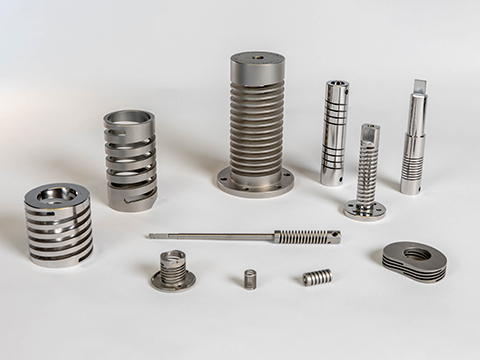
Posted to News on 8th May 2025, 12:00
Discover the benefits of a machined spring in new video from ABSSAC

ABSSAC has produced a new video providing an introduction to machined springs, which meet the needs of applications where design considerations such as accuracy, linearity, repeatability and parallelism are critical, particularly over the long term.

Machined from one piece of material and tailored to meet exact customer size and performance requirements, the machined spring is a formidable package. And for those engineers familiar with the traditional wire-wound spring format, the machined spring offers a new way of looking at both performance and attachment.
The machined spring offers a number of advantages over the wire-wound spring. Prime among these is accuracy, with even the baseline accuracy of 10% being far superior to a wire-wound alternative. Performance can be honed even further from here to give even better accuracy. Similarly, linearity is far superior, with the linear spring rate translating into truly controlled spring motion.
The linear spring rate also ensures excellent repeatability, since it means a controlled stroke and no residual stresses. As the spring can be machined with multiple starts, the bending moments that would be seen with a wire-wound spring during compression can be removed to maintain end face parallelism. This assists with the guidance of the spring and stops additional friction being introduced should the sides be brushing up against adjacent components.
Machining the spring from a solid piece allows for integrated end attachments, eliminating the need for separate components. This offers several advantages: simplified assembly, reduced tolerance stacking, easier inventory and maintenance, and potential weight savings by replacing multiple parts with a single, integrated design.
All of this can mean decisive real-world performance improvements in demanding applications. ABSSAC has seen critical applications with high feedback sensitivity where an accuracy of better than 1% was required; that would be impossible to achieve with a traditional wire-wound spring, but was easily met with a machined spring.
Further, with the machined spring providing no residual stresses, as soon as the force or torque is applied, it is immediately seen within the motion of the spring. Contrast that with the traditional wire-wound spring, which would often have 'dead coils'. This means a difference rate: with a compression spring, for example, the initial part of the stroke has to be overcome before the active coils are in use.
These benefits suit the machined spring to use in some of the most demanding applications, in areas such as aerospace, medical, oil and gas, defence and motorsport all areas where precision are repeatability are key. Space is also becoming an important application area, given the need to reduce component count, simplify assembly, and ease replacement requirements.
This wide range of applications are met not only by the spring's performance, but also by the wide range of materials from which the spring can be machined. These include the likes of Inconel for high temperatures and/or corrosion resistance, while corrosion resistance requirements can also be met using titanium or stainless steel. Titanium, along with materials such as BiodurTM, also enable bio-compatibility requirements to be met.
There are high strength options, too, such as maraging steel, as well as a range of materials to suit other specific application requirements, including aluminium alloys, ToughmetTM, Delrin and many others.
Design freedom
A unique feature of the machined spring is the range of complex geometries that can only be achieved through machining, affording tremendous design freedom. For example, while the machined spring can be made with right-hand and left-hand flexures, the same as with a wire wound spring, a key difference is that in the machined spring these can be combined within the same part to remove rotation during compression. This integration of LH and RH flexures in the same compressive stroke enables accurate end face alignment/timing to be achieved, which can be important if the part is rotating and attached to an encoder relying on positional feedback.
Additionally double, triple and higher numbers of starts are unique to the machined spring, removing the bending moment during compression. This is also the case for torsion spring attachments that can be integrated to ensure the torsion is a true moment and not offset as would be the case with traditional wire wound springs with bent tangs.
In many applications, that list of performance advantages alone would justify the increased cost implied by machining the spring, but there are further benefits over the lifetime of the spring that can make it an even more attractive option.
One of the long-term benefits of the machined spring is reduced maintenance of the system, thanks to multi-part integration, leading to a reduction of downtime within the application. Further the end product becomes an enhanced item thanks to the predictable, constant spring rate which leads to extended life and reliability of the machined spring compared with its wire wound counterpart.
In addition, the consistent performance of a machined spring can also contribute to improved product reliability, not just of the component itself, but of the wider application. Finally, the life expectancy can be predicted through finite element analysis and the stresses seen during the spring operating cycle. And durability is also improved with the residual stresses being eliminated.
So the next time you require a spring in a critical, high performance or high duty cycle environment, the machined spring from ABSSAC may be the answer to your design problems.







